találd ki, mi hiányzik a
poénhoz – a fordítás igazából csak a (tanulnivaló!) szavak
miatt lenne nehéz, de adok segítséget :)
segítség a nyelvtanhoz:
* igeidők (videó)
Wikipedia: A jury is a sworn body of people convened to render an impartial verdict (a finding of fact on a question) officially submitted to them by a court, or to set a penalty or judgment. Modern juries tend to be found in courts to ascertain the guilt, or lack thereof, in a crime. In Anglophone jurisdictions, the verdict may be guilty or not guilty (not proven; a verdict of acquittal, based on the state's failure to prove guilt rather than any proof of innocence, is also available in Scotland). The old institution of grand juries still exists in some places, particularly the United States, to investigate whether enough evidence of a crime exists to bring someone to trial.
The modern criminal court jury arrangement has evolved out of the medieval juries in England. Members were supposed to inform themselves of crimes and then of the details of the crimes. Their function was therefore closer to that of a grand jury than that of a jury in a trial...
About 50 prospective jurors awaiting jury selection
...In Scotland, a jury in a criminal trial consists of 15 jurors, which is thought to be the largest in the world. In 2009 a review by the Scottish Government regarding the possibility of reduction led to the decision to retain 15 jurors, with the Secretary for Justice stating that after extensive consultation, he had decided that Scotland had got it "uniquely right". Trials in the Republic of Ireland which are scheduled to last over 2 months can, but do not have to, have 15 jurors.
A study by the University of Glasgow suggested that a civil jury of 12 people was ineffective because a few jurors ended up dominating the discussion, and that seven was a better number because more people feel comfortable speaking, and they have an easier time reaching a unanimous decision...
A wine jury
...Besides petit juries for jury trials and grand juries for issuing indictments, juries are sometimes used in non-legal or quasi-legal contexts. Blue ribbon juries attend to civic matters as an ad-hoc body in the executive branch of a government. Outside government, a jury or panel of judges may make determinations in competition, such as at a wine tasting, art exhibition, talent contest, or reality game show. These types of contests are juried competitions.


